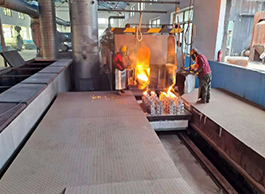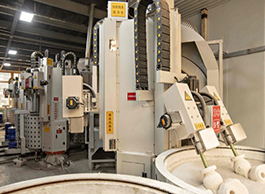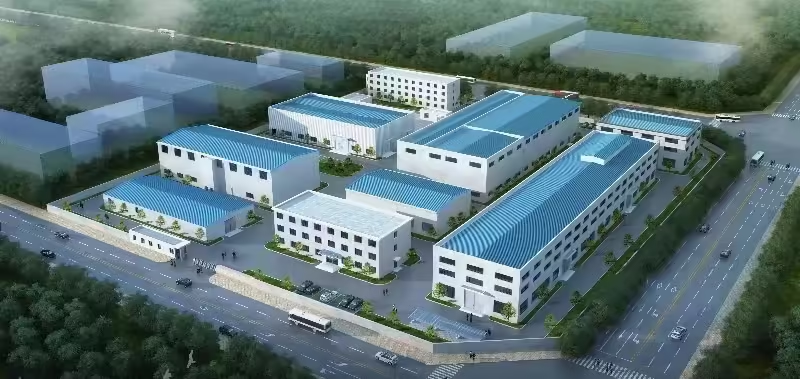Tuangan Keluli Aloi: Panduan Komprehensif untuk Bahan, Proses dan Aplikasi
Jadual Kandungan
pengenalan

Tuangan Keluli Aloi are metal components produced by pouring molten alloy steel into molds, forming parts with high strength, durability, and wear resistance. By modifying the base composition of carbon steel with elements like chromium, nickel, or molybdenum, alloy steel offers tailored properties for demanding industrial applications.
What Makes Tuangan Keluli Aloi Important?
They play a vital role in modern engineering, providing superior performance where ordinary carbon steels fail—such as in heavy machinery, mining equipment, power generation, and transportation.
Understanding the Basics of Tuangan Keluli Aloi
The Concept of Alloy Steel
Alloy steel is steel combined with one or more alloying elements (Cr, Ni, Mo, Mn, V, Si, etc.) to enhance its mechanical and chemical properties.
These additions alter the steel’s internal structure, improving strength, toughness, corrosion resistance, and temperature stability.
How Alloy Steel Differs from Carbon Steel
While carbon steel relies mainly on carbon content for strength, alloy steel depends on the synergy between multiple elements.
As a result, alloy steel castings can achieve higher performance under stress, wear, or heat conditions compared to carbon steel castings.
Types of Tuangan Keluli Aloi

Low-Alloy Steel Castings
Contain small amounts of alloying elements (typically <5%). They balance cost and performance, offering good strength and toughness for general engineering applications.
High-Alloy Steel Castings
Feature higher concentrations of alloying elements, such as chromium and nickel, delivering enhanced corrosion and heat resistance. Commonly used in marine and chemical environments.
Special-Purpose Alloy Castings
Designed for specific performance needs—such as wear-resistant, heat-resistant, or cryogenic steels—used in mining, energy, and aerospace sectors.
Alloying Elements and Their Effects
| unsur | Function | Faedah Utama |
|---|---|---|
| Chromium (Cr) | Increases hardness and corrosion resistance | Wear & rust prevention |
| Nickel (Ni) | Improves toughness and impact resistance | Enhanced ductility |
| Molybdenum (Mo) | Boosts high-temperature strength | Heat performance |
| Vanadium (V) | Refines grain structure | Increased strength |
| Silikon (Si) | Enhances oxidation resistance | Surface stability |
These elements work together to create microstructures that balance strength, toughness, and durability in alloy steel castings.
Manufacturing Process of Tuangan Keluli Aloi

Melting and Refining
The process starts by melting raw materials in an electric arc or induction furnace. Refining techniques like AOD or VOD remove impurities and control composition.
Molding and Pouring
Sand or 3D-printed molds shape the liquid metal. Precise temperature and flow control ensure uniform solidification and minimal defects.
Rawatan Haba
Post-casting heat treatment—such as quenching and tempering—adjusts the hardness and ductility. It transforms the internal structure to achieve target mechanical properties.
Machining and Inspection
Machining ensures dimensional accuracy, while non-destructive testing (UT, RT, PT) confirms internal quality and defect-free casting integrity.
Sifat-sifat Utama bagi Tuangan Keluli Aloi
Kekuatan Mekanikal
Alloy steel castings offer superior tensile and yield strength, ideal for components under high stress.
Toughness and Ductility
They retain impact resistance even in low temperatures or heavy-load environments.
Corrosion and Wear Resistance
Chromium and molybdenum additions provide enhanced surface protection against oxidation, abrasion, and chemical attack.
Perbandingan: Tuangan Keluli Aloi vs Carbon Steel Castings
| Harta benda | Tuangan Keluli Aloi | Tuangan Keluli Karbon |
|---|---|---|
| kekuatan | Higher, customizable | Sederhana |
| Rintangan Kakisan | Cemerlang | Terhad |
| Rintangan Haba | tinggi | Sederhana |
| kos | Higher (due to alloy elements) | Lebih rendah |
| Aplikasi | Heavy-duty, specialized | General-purpose |
Choosing between alloy and carbon steel castings depends on the balance of performance requirements, cost, and environmental conditions.
Common Applications of Tuangan Keluli Aloi
Peralatan Industri
Used in turbines, valve bodies, pump casings, and pressure vessels where strength and heat resistance are essential.
Mining and Construction
Wear-resistant castings for crushers, mills, and excavators.
Transportation and Marine
Components like gears, axles, and propellers that endure stress and vibration.
Tenaga dan Penjanaan Kuasa
Turbine housings, boiler parts, and fittings exposed to high temperature and pressure.
Quality Standards and Certification
Common standards for alloy steel castings include ASTM A148, ASTM A217, EN 10293, and ISO 3755.
Manufacturers typically implement ISO 9001 quality management systems, ensuring traceability, mechanical property verification, and material certification.
Innovations and Future Trends in Tuangan Keluli Aloi

Smart and Digital Foundries
Integration of AI, sensors, and digital twins enables real-time quality monitoring and predictive maintenance.
Sustainable Manufacturing
Use of recycled steel, energy-efficient furnaces, and low-emission casting processes support green manufacturing.
Computational Alloy Design
Machine learning models and CALPHAD simulations are redefining alloy composition optimization, accelerating material innovation.
Kesimpulan
Alloy Steel Castings stand at the intersection of material science and industrial innovation. By combining multiple alloying elements and advanced manufacturing methods, they deliver unmatched strength, reliability, and adaptability. As digital foundries and sustainable metallurgy evolve, alloy steel will continue to shape the backbone of next-generation engineering and manufacturing.
Soalan Lazim
Apa yang Tuangan Keluli Aloi digunakan untuk?
They’re used in applications that require strength, wear resistance, or heat tolerance—such as turbines, pumps, and mining parts.
Adakah Tuangan Keluli Aloi better than Carbon Steel?
Yes, for high-performance environments. Alloy steels outperform carbon steels in strength, durability, and corrosion resistance, though they come at a higher cost.
boleh Tuangan Keluli Aloi rust?
While not immune, properly alloyed and treated steels (especially with chromium) resist rust far better than plain carbon steels.
How are Tuangan Keluli Aloi heat-treated?
They typically undergo quenching and tempering to achieve the desired hardness and toughness balance.
What’s the difference between cast and forged alloy steel?
Cast alloy steel is melted and poured into molds—ideal for complex shapes. Forged steel is deformed under pressure—better for uniform grain and higher fatigue strength.
How do I choose the right alloy for my casting?
Consider the environment (temperature, corrosion exposure, wear) and required mechanical performance, then select an alloy accordingly.
Kekal Berhubung dengan Kami

Terima kasih kerana membaca! Kami berharap blog ini memberi anda pandangan dan inspirasi yang berharga mengenai siling panel akustik. Jika anda menikmati kandungan tersebut dan ingin sentiasa dikemas kini dengan aliran terkini, petua dan kemas kini di sebalik tabir, kami ingin berhubung dengan anda di media sosial.
📘 Ikuti kami di Facebook: Shanghai Leierwo Industry Trade Co., Ltd.
Sertai komuniti kami yang semakin berkembang di mana kami berkongsi nasihat pakar, sorotan produk dan perbincangan interaktif dengan profesional dan peminat reka bentuk dari seluruh dunia.
Mari teruskan perbualan—jumpa anda di sana!
Kategori Produk
- Bahagian Injap
- Bahagian Pam Air
- Bahagian Kotak Galas
- Bahagian Die Casting
- Produk Pam Keluli Tahan Karat
- Produk Pam Besi Tuang
- Bahagian Injap Untuk Kegunaan Kereta
- Bahagian Kenderaan
- Bahagian Injap Untuk Kegunaan Awam
- Bahagian Pam Vakum KF

